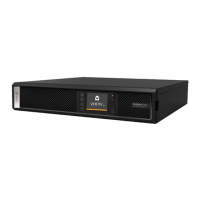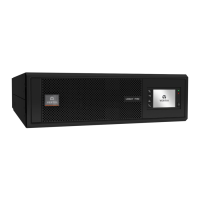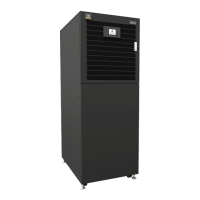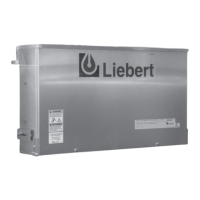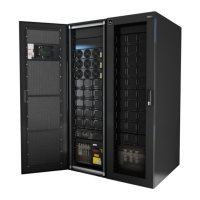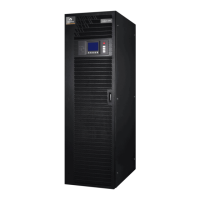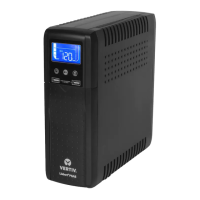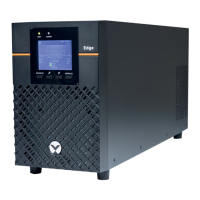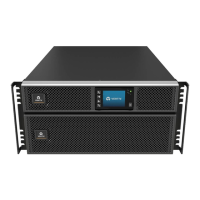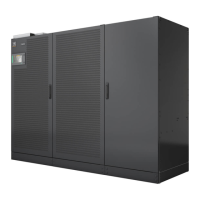Do you have a question about the Vertiv Liebert ITA2 30kVA and is the answer not in the manual?
Defines the meaning and usage of Warning, Danger, and Caution notifications.
Explains the purpose and information provided by Note notifications.
Details safety precautions for personnel involved with the UPS.
Outlines safety measures related to the UPS product itself.
Ensures protection against electrical backfeed.
Lists relevant safety and compliance standards.
Addresses safety measures for high earth leakage current.
Identifies components accessible or not accessible by users.
Highlights the main functionalities and advantages of the UPS.
Details the available model types and their configurations.
Visual description and identification of the UPS components.
Explains the internal workings and power flow of the UPS.
Describes the various operational states and modes of the UPS.
Provides detailed technical specifications for the UPS.
Guidelines for qualified engineers performing installation.
Steps for inspecting the UPS upon unpacking.
Safe methods for moving and transporting the UPS unit.
Pre-installation steps including location and environmental checks.
Lists the necessary tools for UPS installation.
Guidance on selecting and installing external protective devices.
Physical installation guidelines for the UPS.
Detailed procedures for connecting power cables.
Steps for initial setup, configuration, and startup of the UPS.
Highlights unique features of parallel UPS configurations.
Essential requirements for setting up a parallel UPS system.
Physical installation guidelines for parallel UPS units.
Guidelines for connecting power cables in parallel UPS systems.
Procedures for setting up and commissioning parallel UPS systems.
Installation and commissioning procedures for dual bus UPS systems.
Overview of the UPS operation and display panel.
Description of the run and alarm LED indicators.
Explanation of the UPS audible alarm signals.
Details on LCD screen elements and functional buttons.
Guides user through initial UPS setup and parameter configuration.
Diagram illustrating the navigation of the UPS LCD menu.
Describes the different types of screens displayed on the LCD.
Shows input, bypass, battery, output, and load status.
Displays configurable parameters for UPS operation.
Provides controls for UPS functions like power and testing.
Displays current and historical event logs.
Shows product, network, and efficiency details.
Access to maintenance functions, requiring password.
Alerts and confirmations for system operations.
Comprehensive list of UPS alarms and their descriptions.
Step-by-step guide for starting up the UPS.
Guides on transferring the UPS between different operating modes.
Detailed procedure for safely shutting down the UPS.
Explanation of the Remote Emergency Power Off function.
Details on the UPS's automatic restart capability.
How to change the display language of the UPS.
Procedure for setting the UPS system date and time.
Instructions for setting or changing the UPS access password.
Instructions for installing communication cards.
Details on connecting cables to dry contact ports.
Procedure for connecting the UPS via USB.
Procedure for connecting the UPS via serial port.
Details on connecting the UPS control port.
Instructions for network connection via Ethernet port.
Guidelines for maintaining and checking UPS fans.
Procedures and recommendations for battery care.
Instructions for cleaning the UPS unit for optimal airflow.
Methods for checking the UPS operational status.
Procedures for verifying the UPS functions.
List of optional accessories for the UPS.
Details and descriptions of the POD option.
Information on communication cables for parallel systems.
Details on guide rails for rack installation.
Components and cables for dual bus system configurations.
Overview of communication options and monitoring sensors.
Defines the meaning and usage of Warning, Danger, and Caution notifications.
Explains the purpose and information provided by Note notifications.
Details safety precautions for personnel involved with the UPS.
Outlines safety measures related to the UPS product itself.
Ensures protection against electrical backfeed.
Lists relevant safety and compliance standards.
Addresses safety measures for high earth leakage current.
Identifies components accessible or not accessible by users.
Highlights the main functionalities and advantages of the UPS.
Details the available model types and their configurations.
Visual description and identification of the UPS components.
Explains the internal workings and power flow of the UPS.
Describes the various operational states and modes of the UPS.
Provides detailed technical specifications for the UPS.
Guidelines for qualified engineers performing installation.
Steps for inspecting the UPS upon unpacking.
Safe methods for moving and transporting the UPS unit.
Pre-installation steps including location and environmental checks.
Lists the necessary tools for UPS installation.
Guidance on selecting and installing external protective devices.
Physical installation guidelines for the UPS.
Detailed procedures for connecting power cables.
Steps for initial setup, configuration, and startup of the UPS.
Highlights unique features of parallel UPS configurations.
Essential requirements for setting up a parallel UPS system.
Physical installation guidelines for parallel UPS units.
Guidelines for connecting power cables in parallel UPS systems.
Procedures for setting up and commissioning parallel UPS systems.
Installation and commissioning procedures for dual bus UPS systems.
Overview of the UPS operation and display panel.
Description of the run and alarm LED indicators.
Explanation of the UPS audible alarm signals.
Details on LCD screen elements and functional buttons.
Guides user through initial UPS setup and parameter configuration.
Diagram illustrating the navigation of the UPS LCD menu.
Describes the different types of screens displayed on the LCD.
Shows input, bypass, battery, output, and load status.
Displays configurable parameters for UPS operation.
Provides controls for UPS functions like power and testing.
Displays current and historical event logs.
Shows product, network, and efficiency details.
Access to maintenance functions, requiring password.
Alerts and confirmations for system operations.
Comprehensive list of UPS alarms and their descriptions.
Step-by-step guide for starting up the UPS.
Guides on transferring the UPS between different operating modes.
Detailed procedure for safely shutting down the UPS.
Explanation of the Remote Emergency Power Off function.
Details on the UPS's automatic restart capability.
How to change the display language of the UPS.
Procedure for setting the UPS system date and time.
Instructions for setting or changing the UPS access password.
Instructions for installing communication cards.
Details on connecting cables to dry contact ports.
Procedure for connecting the UPS via USB.
Procedure for connecting the UPS via serial port.
Details on connecting the UPS control port.
Instructions for network connection via Ethernet port.
Guidelines for maintaining and checking UPS fans.
Procedures and recommendations for battery care.
Instructions for cleaning the UPS unit for optimal airflow.
Methods for checking the UPS operational status.
Procedures for verifying the UPS functions.
List of optional accessories for the UPS.
Details and descriptions of the POD option.
Information on communication cables for parallel systems.
Details on guide rails for rack installation.
Components and cables for dual bus system configurations.
Overview of communication options and monitoring sensors.
| Model | Liebert ITA2 30kVA |
|---|---|
| Power Rating | 30 kVA |
| Active Power | 30 kW |
| Phase | 3-phase |
| Input Frequency | 50/60 Hz |
| Output Frequency | 50/60 Hz |
| Topology | Double Conversion Online |
| Form Factor | Tower |
| Battery Type | Valve-Regulated Lead-Acid (VRLA) |
| Operating Temperature | 0 to 40 °C |
| Relative Humidity | 0% to 95% (non-condensing) |
| Communication Interface | RS232, USB, SNMP |
